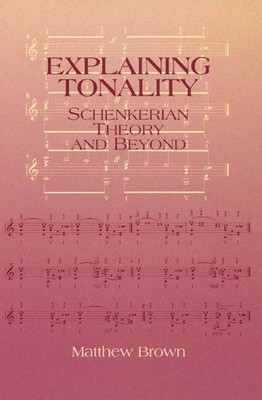
- We will send in 10–14 business days.
- Author: Matthew Brown
- Publisher: University of Rochester Press
- Pages: 315
- ISBN-10: 1580461603
- ISBN-13: 9781580461603
- Format: 16.2 x 23.5 x 2.3 cm, kieti viršeliai
- Language: English
- SAVE -10% with code: EXTRA
Reviews
Description
A defense of Schenkerian analysis of tonality in music.
A wide range of music -- from Bach to Mozart and Brahms -- is marked by its use of some form of what is generally called "tonality" the tendency of music to focus melodically on some stable pitch or tonic and for its harmony to use functional triads. Yet few terms in music theory are more enigmatic than that seemingly simple word "tonality."Matthew Brown's Explaining Tonality: Schenkerian Theory and Beyond considers a number of disparate ways in which functional tonality has been understood. In particular, it focuses on the comprehensive theory developed by Heinrich Schenker in his monumental three-part treatise Neue musikalische Theorien und Phantasien [1906-1935].
Schenker systematically investigated the ways in which lines and chords behave both locally within individual tonal phrases and globally across entire compositions. Explaining Tonality shows why Schenker was able to elucidate tonal relationships so successfully and the many advantages that his explanations have over those of his rivals. In addition, it proposes some ways in which Schenker's approach can be extended to tonal features in works from before Bach [such as Monteverdi] and after Brahms [such as Debussy, Stravinsky, and much popular music of today].
Along the way, the book explores six methodological criteria that help in building, testing, and evaluatinga plausible theory of tonality or, indeed, any other musical phenomenon: accuracy, scope, fruitfulness, consistency, simplicity, and coherence. It reveals how understanding the tonality of a piece can shed light on other aspects of musical composition. And, in conclusion, it describes some ways in which Schenkerian theory might fruitfully develop in the future. Matthew Brown is Professor of Music Theory at the Eastman School of Music, Universityof Rochester, and author of Debussy's "Ibéria" [Oxford University Press].
EXTRA 10 % discount with code: EXTRA
The promotion ends in 22d.04:28:57
The discount code is valid when purchasing from 10 €. Discounts do not stack.
- Author: Matthew Brown
- Publisher: University of Rochester Press
- Pages: 315
- ISBN-10: 1580461603
- ISBN-13: 9781580461603
- Format: 16.2 x 23.5 x 2.3 cm, kieti viršeliai
- Language: English English
A defense of Schenkerian analysis of tonality in music.
A wide range of music -- from Bach to Mozart and Brahms -- is marked by its use of some form of what is generally called "tonality" the tendency of music to focus melodically on some stable pitch or tonic and for its harmony to use functional triads. Yet few terms in music theory are more enigmatic than that seemingly simple word "tonality."Matthew Brown's Explaining Tonality: Schenkerian Theory and Beyond considers a number of disparate ways in which functional tonality has been understood. In particular, it focuses on the comprehensive theory developed by Heinrich Schenker in his monumental three-part treatise Neue musikalische Theorien und Phantasien [1906-1935].
Schenker systematically investigated the ways in which lines and chords behave both locally within individual tonal phrases and globally across entire compositions. Explaining Tonality shows why Schenker was able to elucidate tonal relationships so successfully and the many advantages that his explanations have over those of his rivals. In addition, it proposes some ways in which Schenker's approach can be extended to tonal features in works from before Bach [such as Monteverdi] and after Brahms [such as Debussy, Stravinsky, and much popular music of today].
Along the way, the book explores six methodological criteria that help in building, testing, and evaluatinga plausible theory of tonality or, indeed, any other musical phenomenon: accuracy, scope, fruitfulness, consistency, simplicity, and coherence. It reveals how understanding the tonality of a piece can shed light on other aspects of musical composition. And, in conclusion, it describes some ways in which Schenkerian theory might fruitfully develop in the future. Matthew Brown is Professor of Music Theory at the Eastman School of Music, Universityof Rochester, and author of Debussy's "Ibéria" [Oxford University Press].


Reviews